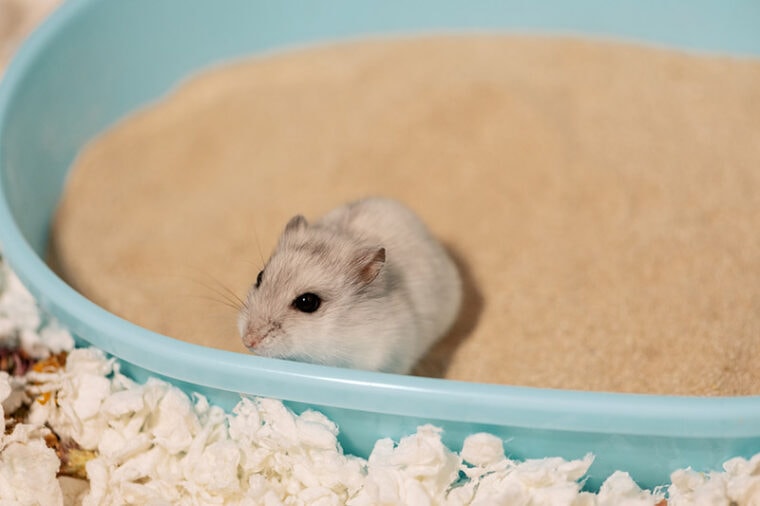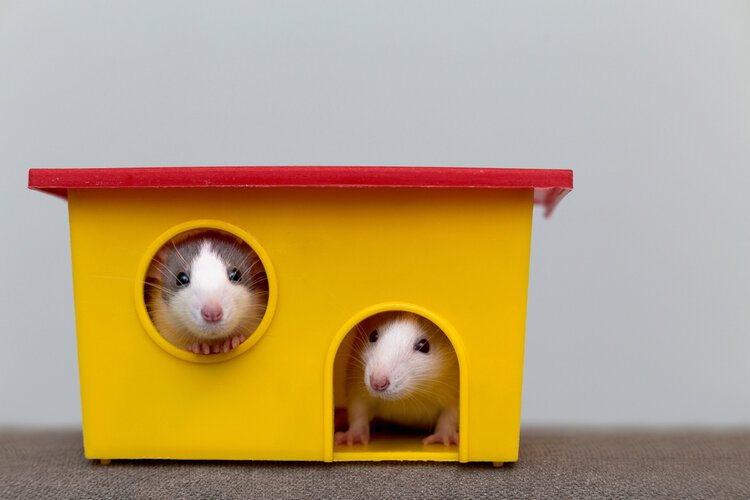
Click to Skip Ahead
Hamsters make great pets because they’re relatively easy to care for, children love them, and they don’t take up as much space as dogs and cats do. However, hamsters aren’t a hands-off type of pet. They must be housed, fed, and provided with opportunities to clean themselves in a way that promotes good health and happiness.
Hamsters don’t need water for bathing, instead they use sand. These rodents come from desert environments without much access to water. They evolved to use the sand in their environment to bathe themselves and keep their coats healthy. Sand is a convenient material for pet owners because it can also be used as litter, and hamsters naturally gravitate toward it for relieving themselves as they would in the wild. Here’s everything that you should know about hamster sand baths.
How Does It Work?
The whole idea of a sand bath is for the sand to mechanically remove impurities and extra skin oils. The sand gently rubs away natural oils that have built up on the skin and in the coat to help maintain a proper balance without the excessive drying that water and soap can bring. Sand bathing also helps keep the hair soft, free of dirt and debris, and reduce odors.
On top of this, hamster sand baths provide your pet with exercise and mental enrichment. Hamsters also enjoy the activity because it feels good when they rub around and play in the smooth, exfoliating material.
The best way to make a hamster sand bath is to fill a small, wide bowl with hamster sand bath-specific sand and place it in your hamster’s habitat.
The dish should be small enough for your hamster to climb into, yet large enough for them to roll around and dig into. You can also use sand as filler for the bottom of the habitat instead of the litter that you would normally use. The sand will enhance your pet’s enrichment opportunities within the habitat and help keep them busy, so it’s a good idea to keep sand in the habitat all the time.
Alternatively, you can add sand to the habitat once or twice a week to keep things interesting and to ensure that the space does not get overcrowded. If there is no space in the habitat to safely introduce sand to, you can create a “sand park” by filling a plastic tub with about 1 inch of sand, adding hamster-friendly toys, and letting your hamster roll around in it a few times a week for supervised bath time and fun.

Where Is It Used?
Although a hamster’s habitat or another enclosed container is the safest spot for a hamster to take a sand bath, there is no right or wrong place. You can spread a few handfuls of sand on an enclosed patio for supervised playtime, or fill a bowl with sand and let your hamster play in it on the coffee table while you watch. As long as your hamster is safe, they can spend time in sand almost anywhere.
What Are the Different Types of Hamster Sand Baths?
Multiple different types of sand can be used for a hamster sand bath. By using different types, you can provide your hamster with various stimulating bath materials throughout the year. Here are the types of sand that are best for hamster sand baths:
Now, let’s take a look at the types of sand that are not suitable for hamster baths:
It’s best to use a commercial product that is designed specifically for hamsters. This way, you won’t need to worry whether the sand will be safe or healthy for your beloved pet. Your veterinarian can provide specific recommendations if necessary.

Frequently Asked Questions (FAQ)
Here are a few frequently asked questions and their answers to help you better understand hamster sand baths.
Do Hamsters Always Need Sand Baths?
As long as their habitat is cleaned regularly, hamsters can usually groom themselves. However, sand baths make hamsters happy and can do things that self-cleaning can’t, like help control excess skin and coat oils. So, while your hamster won’t die without sand baths, they won’t be as happy and healthy as they would be with them.
How Often Should Hamster Sand Baths Be Provided?
There is no right or wrong answer here. You can keep sand in your hamster’s habitat so they have access to it daily, or you can provide them with access to a sand bath once or twice a week. That said, the more often your hamster has access to sand, the happier they’re likely to be overall.
Can Hamsters Have Water Baths Too?
Hamsters can technically get bathed in water, but there is rarely a need to do so. Your vet may recommend a water bath if your hamster has feces or urine clinging to their hind end that could create other health issues. However, pet wipes may work to clean this area as well. For general cleaning, it is safer and easier to provide your hamster with sand baths and let them clean themselves.
Conclusion
Hamster sand baths are ideal for your pet to clean themselves and get the exercise that they need to stay happy and healthy. Creating a sand bath for your hamster is easy to do, and your pet will reap the benefits.
Featured Image Credit: IRINA ORLOVA, Shutterstock









